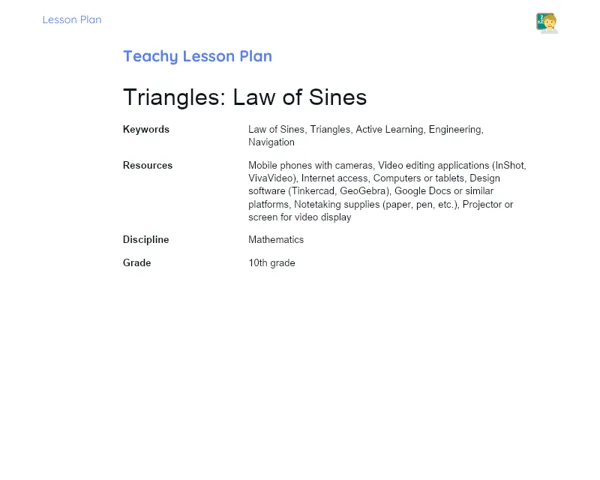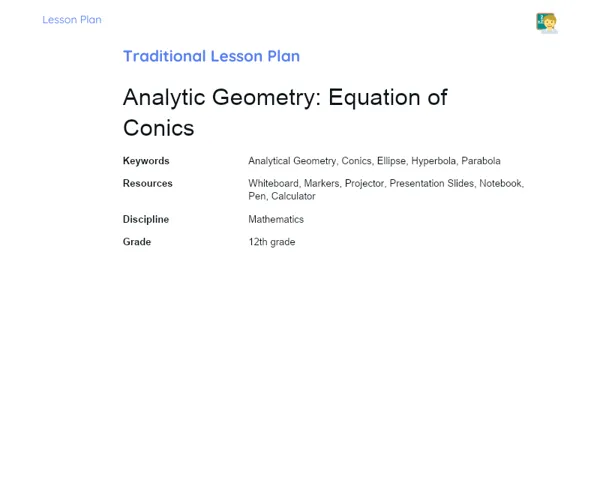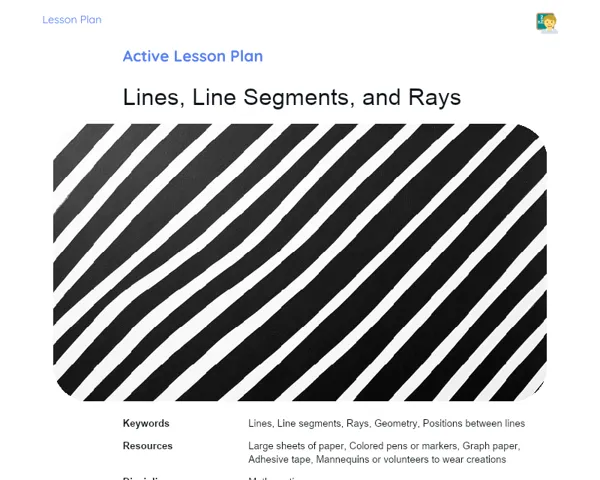Lesson Plan | Active Methodology | Volume and Area: Cylinder
| Keywords | Cylinder Volume, Surface Area, Practical Calculation, Group Activities, Problem-based Situations, Cylinders in Events and Cities, Applications of Volume Calculation, Teamwork, Group Discussion, Theory-Practice Connection |
| Necessary Materials | Graph paper, Ruler, Calculator, Projector for presentations, Writing materials (pens, pencils) |
Premises: This Active Lesson Plan assumes: a 100-minute class duration, prior student study both with the Book and the beginning of Project development, and that only one activity (among the three suggested) will be chosen to be carried out during the class, as each activity is designed to take up a large part of the available time.
Objective
Duration: (5 - 10 minutes)
This Objectives phase is essential to establish the lesson's focal point, ensuring both teacher and students have a clear understanding of what will be tackled. By defining specific objectives, students can steer their study approach and classroom involvement, thereby enhancing the effectiveness of their learning. During this phase, the teacher guides students on the expected outcomes and how they can leverage this knowledge in real-world applications.
Objective Utama:
1. Enable students to accurately calculate the volume of a cylinder, grasping the mathematical formula and its relevance in real-life scenarios.
2. Equip students with the skills to determine both lateral and total surface area of a cylinder, reinforcing their learning with practical examples.
Objective Tambahan:
- Encourage logical thought and the practical application of mathematical ideas to everyday challenges.
- Foster teamwork and discussion among students during practical tasks to deepen their understanding.
Introduction
Duration: (15 - 20 minutes)
The introduction aims to engage students while revisiting previously learned concepts. By presenting them with problem situations that stimulate critical thinking, we can illustrate the practical relevance of mathematical knowledge. Using real-life examples helps highlight the significance of mathematics, thereby boosting student engagement and interest.
Problem-Based Situation
1. Imagine you are tasked with organizing an event at a cylindrical venue, such as a large tent. How would you calculate the volume to make sure all guests are comfortably accommodated?
2. Consider a scenario where you are renovating an industrial kitchen and have cylindrical storage tanks for ingredients. How would you calculate the external surface area of these tanks to ensure that the right amount of coating is applied?
Contextualization
Cylinders are ubiquitous in various practical uses, from cool drink cans to storage tanks in industries. Understanding how to compute the volume and surface area of cylinders is vital not only for mathematics but also for numerous everyday tasks, like packaging design, architecture, and engineering. Mastery of these concepts allows for better resource optimization, making it a valuable competency across different professions and daily activities.
Development
Duration: (70 - 75 minutes)
The Development phase invites students to apply their understanding of volume and surface area calculations for cylinders in practical scenarios they have previously studied. Through engaging and collaborative tasks, they can explore diverse challenges, solidifying their mathematical skills while promoting teamwork and communication.
Activity Suggestions
It is recommended that only one of the suggested activities be carried out
Activity 1 - The Mathematical Cylinder Festival
> Duration: (60 - 70 minutes)
- Objective: Apply volume calculation knowledge in a practical, collaborative environment while fostering teamwork and communication skills.
- Description: In this activity, students are tasked with designing a festival utilizing cylindrical structures. The scenario places them in an event organizing team responsible for plotting out booths, stages, and rest areas in a cylindrical field. Each group receives the field dimensions and must determine the volume required for each structure based on its functionality.
- Instructions:
-
Divide the class into groups of up to 5 students.
-
Provide the dimensions of the cylindrical field and define the roles for each structure (stage, booth, restrooms, etc.).
-
Each group calculates the volume required for every structure, considering the capacity for people and equipment.
-
Groups must present a layout plan outlining the dimensions of each structure and the total volume calculation for all components.
-
Encourage a class discussion where each group explains their decisions based on the calculations performed.
Activity 2 - Mini-City Architects
> Duration: (60 - 70 minutes)
- Objective: Encourage the practical application of volume calculations while fostering critical and creative thinking in urban design challenges.
- Description: Students, organized in groups, will take on the role of architects tasked with designing a mini-city within a cylindrical space. They must compute the total available volume and decide how to allocate different types of constructions (residential, commercial, green spaces) to maximize land usage. This challenge combines volume calculation with a creative approach to urban planning.
- Instructions:
-
Form groups of up to 5 students and provide them with the cylindrical space dimensions.
-
Explain that each group is to calculate the total volume and plan the city layout to optimize land use.
-
Students will calculate the volume for each type of construction and green space they wish to include, ensuring that the total doesn’t exceed the cylinder’s volume.
-
Each group must draw their city plan on graph paper and present their project, explaining their planning decisions.
-
Hold a voting session to choose the most creative and effective use of space.
Activity 3 - Cylinders in Space: An Interplanetary Adventure
> Duration: (60 - 70 minutes)
- Objective: Build knowledge of volume and surface area calculations in an interdisciplinary context of science and engineering, fostering critical thinking and teamwork.
- Description: In this activity, students function as space scientists tasked with designing a space station composed of cylindrical sections for living quarters, laboratories, and food production. They need to calculate the volume and surface area necessary for each section, considering the astronauts' requirements and the limitations of their interplanetary spacecraft.
- Instructions:
-
Group the class into teams of up to 5 students and assign each group a specific section type to design (living quarters, labs, food production).
-
Provide the spaceship dimensions along with the cylinders to be designed.
-
Students will compute the volume and surface area of each section, accounting for specific needs such as the number of astronauts, equipment, and plants.
-
Each group must demonstrate a technical sketch of their section and share it with the class, discussing the implications of their calculations and design choices.
-
Conduct a 'launch simulation' for the spaceship, where each group presents their section and its integration into the overall ship design.
Feedback
Duration: (15 - 20 minutes)
This phase aims to reinforce learning, allowing students to reflect on their work and articulate the knowledge gained during collective discussions. It also serves as an opportunity for the teacher to assess students' understanding of volume and surface area concepts, while nurturing their communication and argumentation skills. By sharing experiences and considering their peers' solutions, students gain fresh perspectives that enrich their learning.
Group Discussion
To initiate the group discussion, the teacher may prompt each group to provide a brief overview of their project, emphasizing the challenges encountered and the creative solutions they proposed. Following that, encourage students to discuss differences in their projects and how each approached calculations and design with unique strategies. Use questions such as: 'What were some of the major hurdles when calculating volumes and areas?', 'How did you decide on the layout of structures in the cylindrical space?' and 'Was there a concept from another group that you wished you had thought of first?' to guide the dialogue.
Key Questions
1. What are some real-world applications you can envision for the volume and surface area concepts of cylinders after this lesson?
2. How can visualizing and calculating volumes assist in other subjects or daily tasks?
3. What skills, both mathematical and otherwise, do you feel were the most crucial in successfully completing the project?
Conclusion
Duration: (5 - 10 minutes)
The conclusion is intended to reinforce and summarize key learnings from the lesson, ensuring that students can consolidate acquired knowledge. Moreover, it creates a clear link between the mathematical theory covered and its practical relevance, enhancing students' understanding of how the topic applies to their lives and future careers. This recap also facilitates long-term retention and effective application of knowledge beyond the classroom.
Summary
To close today's lesson, let's revisit the key points discussed regarding the volume and surface area of cylinders. We went over the calculation formula for volume and emphasized the importance of these calculations in practical scenarios like event management, urban design, and even space missions.
Theory Connection
Throughout the lesson, we observed how volume calculation theory connects directly with practical activities, like festival planning or mini-city design. This hands-on learning not only aids comprehension of mathematical concepts but also showcases their applicability in everyday life and various career paths.
Closing
In conclusion, the understanding gained from calculating the volume and surface area of cylinders is highly applicable in everyday situations, helping optimize resources, plan spaces, and address practical challenges across various fields. Students are now equipped to recognize and apply these principles in diverse contexts, underscoring the significance of mathematics in real-world scenarios.



